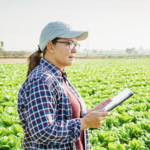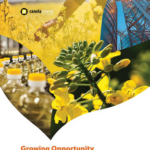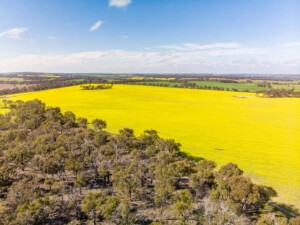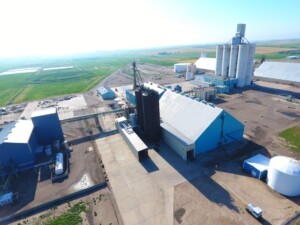|
Canola Quick Bytes
A supplement to U.S. Canola Digest
Capitol Hill
 Members of the U.S. House of Representatives, led by Rep. James Baird of the House Committee on Agriculture, sent a letter on March 25 to the U.S. Environmental Protection Agency (EPA) to call for its immediate withdrawal of the Vulnerable Species Pilot Program and Herbicide Strategy issued as part of the EPA’s Endangered Species Act implementation efforts. “These proposals will only create greater uncertainty in rural America, have severe economic impacts on producers, and have unintended negative consequences on the very species they are designed to protect,” they wrote. These concerns are shared by the U.S. Department of Agriculture (USDA) and countless grower groups, including the U.S. Canola Association (USCA). In addition to withdrawal of the “impractical proposals,” the 44 members of Congress asked the EPA to renegotiate the Stipulated Settlement Agreement to add time to rewrite the proposals and utilize the USDA and stakeholder expertise in production agriculture. “Canola growers fully support sustainable agriculture, championing innovation and responsible farming practices,” noted USCA President Andrew Moore. “To this end, we encourage the EPA to … develop practical solutions that prioritize both environmental protection and the viability of American agriculture. Mitigations should be cost-effective, targeted and flexible.” Members of the U.S. House of Representatives, led by Rep. James Baird of the House Committee on Agriculture, sent a letter on March 25 to the U.S. Environmental Protection Agency (EPA) to call for its immediate withdrawal of the Vulnerable Species Pilot Program and Herbicide Strategy issued as part of the EPA’s Endangered Species Act implementation efforts. “These proposals will only create greater uncertainty in rural America, have severe economic impacts on producers, and have unintended negative consequences on the very species they are designed to protect,” they wrote. These concerns are shared by the U.S. Department of Agriculture (USDA) and countless grower groups, including the U.S. Canola Association (USCA). In addition to withdrawal of the “impractical proposals,” the 44 members of Congress asked the EPA to renegotiate the Stipulated Settlement Agreement to add time to rewrite the proposals and utilize the USDA and stakeholder expertise in production agriculture. “Canola growers fully support sustainable agriculture, championing innovation and responsible farming practices,” noted USCA President Andrew Moore. “To this end, we encourage the EPA to … develop practical solutions that prioritize both environmental protection and the viability of American agriculture. Mitigations should be cost-effective, targeted and flexible.”
On March 1, the EPA announced it will open a new Office of Agriculture and Rural Affairs to expand engagement with agricultural and rural communities. The first of its kind, the office aims to improve environmental stewardship and economic opportunity for rural America. “Farmers and ranchers are crucial partners as we work together to deliver clean air, clear water, and climate solutions – all while playing the critical role of ensuring an abundant fiber, fuel and food supply,” said EPA Administrator Michael Regan. “With the launch of this new office, we are ensuring agricultural and rural stakeholders will continue to have a seat at the table for many years to come.”
 The USCA joined more than 100 agricultural organizations in a March 15 letter to Senate and House Appropriations Committee leaders calling for much needed resources for federal pesticide programs. They asked for $166 million to fund EPA’s pesticide program; $3 million for the U.S. Fish and Wildlife Service (FWS) for pesticide Endangered Species Act (ESA) consultations; and language directing the EPA to: The USCA joined more than 100 agricultural organizations in a March 15 letter to Senate and House Appropriations Committee leaders calling for much needed resources for federal pesticide programs. They asked for $166 million to fund EPA’s pesticide program; $3 million for the U.S. Fish and Wildlife Service (FWS) for pesticide Endangered Species Act (ESA) consultations; and language directing the EPA to:
- use the best available science in its assessments,
- allow third parties to do biological evaluations for regulatory efficiency;
- ensure epidemiological data can be verified and is fit for regulatory purposes;
- refrain from approving pesticide labels inconsistent with risk assessments;
- develop via the FWS sub-county level species maps when possible; and
- consult with stakeholders prior to publishing any ESA proposals/mitigations.
The USCA signed comments developed by the Growing Matters coalition in response to a petition by Public Employees for Environmental Responsibility and the American Bird Conservancy that calls for the EPA to require efficacy data and more for neonicotinoids and other systemic pesticides. The EPA comment period closed March 25.
A group of senators wrote to Senate and House leadership March 6 to urge freezing the Adverse Effect Wage Rate that determines costs for H-2A employees. Senators in canola-producing states who signed the letter include Kevin Cramer and John Hoeven of N.D., Jim Risch of Idaho, and Jerry Moran and Roger Marshall of Kansas. While the rate varies by state, the national average is $17.55 per hour this year, up 5.6% from 2023.
The USDA Commodity Credit Corporation announced on March 29 the 2024 Marketing Assistance Loan rates. For canola, it is $10.09 per hundredweight through March 31, 2025.
Agronomy
 In its March 28 Prospective Plantings report, the USDA’s National Agricultural Statistics Service (NASS) estimates planted area of canola at a record high of nearly 2.37 million acres in 2024, up about 22,000 acres from last year. Prospective plantings in North Dakota are 1.8 million acres and in Washington 160,000, down about 130,000 and 5,000, respectively from 2023. Planting estimates in other primary canola-growing states are up considerably with Montana at 190,000, Minnesota at 96,000, Idaho at 90,000, Oklahoma at 22,000 and Kansas at 8,500. In its March 28 Prospective Plantings report, the USDA’s National Agricultural Statistics Service (NASS) estimates planted area of canola at a record high of nearly 2.37 million acres in 2024, up about 22,000 acres from last year. Prospective plantings in North Dakota are 1.8 million acres and in Washington 160,000, down about 130,000 and 5,000, respectively from 2023. Planting estimates in other primary canola-growing states are up considerably with Montana at 190,000, Minnesota at 96,000, Idaho at 90,000, Oklahoma at 22,000 and Kansas at 8,500.
The annual BeSure! campaign once again reminds growers of proper stewardship practices during planting season to help protect pollinators. Resources are available from the Growing Matters coalition, American Seed Trade Association and CropLife America.
Nutrition
 Did you know that canola oil is a good source of vitamins E and K? Just one serving (1 Tbsp) provides for adults 16% of the recommended daily intake for vitamin E and 20% for vitamin K. Vitamin E is an antioxidant that may help protect the heart, which tends to fall short in the American diet. Vitamin K helps maintain normal blood flow. Did you know that canola oil is a good source of vitamins E and K? Just one serving (1 Tbsp) provides for adults 16% of the recommended daily intake for vitamin E and 20% for vitamin K. Vitamin E is an antioxidant that may help protect the heart, which tends to fall short in the American diet. Vitamin K helps maintain normal blood flow.
Other Countries
 At its annual general meeting on March 7, the Canola Council of Canada (CCC) elected Tessa Ritter, stakeholder relations manager at Viterra, as its new board chair for a two-year term. She succeeds Jennifer Marchand, who remains on the board as a director. President & CEO Chris Davison also presented the 2023 annual report, “Growing Opportunity,” which highlights growing diversification in biofuel markets; renewed investment in research, market access and development; establishing resources in the Indo-Pacific region; revitalizing connections with China and other key markets; and canola agronomy in the brown soil zone. At its annual general meeting on March 7, the Canola Council of Canada (CCC) elected Tessa Ritter, stakeholder relations manager at Viterra, as its new board chair for a two-year term. She succeeds Jennifer Marchand, who remains on the board as a director. President & CEO Chris Davison also presented the 2023 annual report, “Growing Opportunity,” which highlights growing diversification in biofuel markets; renewed investment in research, market access and development; establishing resources in the Indo-Pacific region; revitalizing connections with China and other key markets; and canola agronomy in the brown soil zone.
A new Cargill Power CanolaTM program in Canada makes it easy for growers to benefit from new and expanding market opportunities for renewable fuel feedstocks. Canada’s Clean Fuel Regulations, the U.S. Renewable Fuel Standard and the EU’s 2BS voluntary sustainability program all recognize canola as a low-carbon intensity feedstock when grown sustainably. To qualify for Cargill’s program, canola must be grown on land that is not a protected area, grassland, watershed, riparian zone or home to “at-risk-species”. Environment and Climate Change Canada recognizes all Canadian cropland to have met these criteria. Enrolment is open now for the 2024 crop year.
 Australia is expected to export 4.4 million tonnes of canola this year, down from 5.87 million tonnes last year, but still double the volume it used to ship out annually, reported The Western Producer. Canada is facing strong competition from Australia in many canola export markets, including Japan, Mexico, Pakistan, United Arab Emirates and European Union, said Jarrett Beatty, an exporter with Parrish & Heimbecker. Australia is “going to continue to be a bit of a thorn in our side in terms of capturing market share,” he noted, especially with its canola recently selling at a $50 to $100 per tonne discount in some markets due to a whopping harvest of 8.27 million tonnes. As well, Australian canola typically has higher oil content (46-47%) than Canada’s (43-44%) because it is grown as a winter crop. Beatty added that Canada has an advantage in China because of its 1% dockage regulations that Australia cannot meet. Australia is expected to export 4.4 million tonnes of canola this year, down from 5.87 million tonnes last year, but still double the volume it used to ship out annually, reported The Western Producer. Canada is facing strong competition from Australia in many canola export markets, including Japan, Mexico, Pakistan, United Arab Emirates and European Union, said Jarrett Beatty, an exporter with Parrish & Heimbecker. Australia is “going to continue to be a bit of a thorn in our side in terms of capturing market share,” he noted, especially with its canola recently selling at a $50 to $100 per tonne discount in some markets due to a whopping harvest of 8.27 million tonnes. As well, Australian canola typically has higher oil content (46-47%) than Canada’s (43-44%) because it is grown as a winter crop. Beatty added that Canada has an advantage in China because of its 1% dockage regulations that Australia cannot meet.
On March 26, European farmers protested for the third time this year in Brussels against hardship they blame on EU green policies, price pressures and import competition, reported Politico. The protest included some demonstrators throwing firebombs and debris at law enforcement. Belgian Interior Minister Annelies Verlinden condemned the riots, saying that the “violence, arson and destruction” was “unacceptable.” Similar violence erupted earlier this year when farmers in Brussels toppled a statue and hurled eggs at the European Parliament.
Latest Industry News
Due to a petition from oilseed growers, the Montana Department of Agriculture will hold a public hearing on Wed., April 10, at 1 pm MT to gage public interest in the potential creation of an oilseed checkoff to be directed through an oilseed advisory committee. The meeting will be remote via Zoom; e-mail Dani Jones at danielle.jones@mt.gov for information to join. Montana ranks third in canola production nationwide.
 In a March 20 podcast by Clean Fuels Alliance America, Alan Weber, consultant to Clean Fuels and founder of MARC-IV, discussed winter canola’s potential in biofuel production with Chad Berghoefer, global product director – biofuels at Corteva Agriscience. Corteva aims to increase winter canola production in the mid-south (western Kentucky and Tennessee) – where it currently has 5,000 planted acres – as a feedstock for low-carbon biofuels. Berghoefer explained the difference between spring and winter canola, how the latter grows and why it’s a great rotational crop. Winter canola requires a “cold spell” and can stand temperatures down to zero to some extent, he noted. In a March 20 podcast by Clean Fuels Alliance America, Alan Weber, consultant to Clean Fuels and founder of MARC-IV, discussed winter canola’s potential in biofuel production with Chad Berghoefer, global product director – biofuels at Corteva Agriscience. Corteva aims to increase winter canola production in the mid-south (western Kentucky and Tennessee) – where it currently has 5,000 planted acres – as a feedstock for low-carbon biofuels. Berghoefer explained the difference between spring and winter canola, how the latter grows and why it’s a great rotational crop. Winter canola requires a “cold spell” and can stand temperatures down to zero to some extent, he noted.
Bunge and Chevron announced on March 4 approval of a final investment decision for their joint venture Bunge Chevron Ag Renewables LLC to build a new oilseed processing plant adjacent to its existing facility in Destrehan, La. The announcement was celebrated with a groundbreaking event there. The switch plant will process winter canola among other oilseeds. It should be operational in 2026, helping the new company meet increasing market demand for renewable fuel feedstocks. It will also support the growing feed and protein markets.
In Red River Farm Network’s latest “Canola Minute”, Northern Canola Growers Association Executive Director Barry Coleman noted that demand for canola oil-based biofuels continues to increase as reflected in statistics. The U.S. Energy Information Administration reported that 3.38 billion pounds of canola oil were used in biofuel in 2023. The USDA is increasing its canola crush outlook for 2023-24 as it is already up 11% compared to the previous fiscal year.
 Scoular announced on March 25 that it hired three leaders for its new soy and canola oilseed crush operation in Goodland, Kan.: Michael Meyers, commercial manager; Jeff Frazier, market development manager; and Evan Balthazor, plant superintendent. Frazier will focus on developing strategies to build Scoular’s canola market. The company plans to hire an additional 30 people to support the crush plant before it begins operating in October 2024. Scoular announced on March 25 that it hired three leaders for its new soy and canola oilseed crush operation in Goodland, Kan.: Michael Meyers, commercial manager; Jeff Frazier, market development manager; and Evan Balthazor, plant superintendent. Frazier will focus on developing strategies to build Scoular’s canola market. The company plans to hire an additional 30 people to support the crush plant before it begins operating in October 2024.
Videos are now available from the “Getting it Right in Canola Production” virtual meeting on March 12 hosted by North Dakota State University Extension and supported by the Northern Canola Growers Association (NCGA). Topics include cultivar selection, seeding rate, plant establishment and intercropping, fertilizer recommendations, and disease, insect and weed management.
About the USCA
 The USCA board and membership meeting March 18-20 in Washington, D.C., elected new officers and addressed policy priorities related to appropriations, biofuels, the next farm bill (extended to Sept. 30 2024), crop protection, crop insurance and reference prices. Tim Mickelson was elected president, Dale Flikkema first vice president (VP) and Jeff Mortenson second VP as of April 1. Outgoing President Andrew Moore will remain on the board. External speakers were Kailee Tkacz Buller, CAE, new president & CEO of the National Oilseed Processors Association, and Scott Herndon, president of Field to Market: The Alliance for Sustainable Agriculture. Staff and grower members of the USCA, NCGA, Pacific Northwest Canola Association and Minnesota Canola Council called upon legislators in canola-growing states to support: The USCA board and membership meeting March 18-20 in Washington, D.C., elected new officers and addressed policy priorities related to appropriations, biofuels, the next farm bill (extended to Sept. 30 2024), crop protection, crop insurance and reference prices. Tim Mickelson was elected president, Dale Flikkema first vice president (VP) and Jeff Mortenson second VP as of April 1. Outgoing President Andrew Moore will remain on the board. External speakers were Kailee Tkacz Buller, CAE, new president & CEO of the National Oilseed Processors Association, and Scott Herndon, president of Field to Market: The Alliance for Sustainable Agriculture. Staff and grower members of the USCA, NCGA, Pacific Northwest Canola Association and Minnesota Canola Council called upon legislators in canola-growing states to support:
- crop insurance enhancements, including increased premium support;
- equitable treatment of canola in commodity programs (reference prices, loans);
- funding for canola research ($10 million NIFA-SAC, $2.4 million sclerotinia);
- incorporating canola into GREET modeling to determine tax credits for biofuels;
- science-based regulation of pesticides by the EPA;
- streamlining and expanding the H-2A temporary worker program;
- and improving the plant biotechnology regulatory framework.
The next USCA board meeting will be in San Diego, Calif., Mon.-Wed., Nov. 11-13.
Want to see exactly where spring and winter canola is growing in the United States? The USCA has a canola acreage map by county on its website.
Get social with us on Instagram, LinkedIn, Facebook, Twitter and YouTube.
Want to promote your products or services to canola producers and industry members? Visit our advertising pages to find specs, deadlines and rates to advertise in this monthly e-newsletter or on UScanola.com.
|
 Members of the U.S. House of Representatives, led by Rep. James Baird of the House Committee on Agriculture, sent a letter on March 25 to the U.S. Environmental Protection Agency (EPA) to call for its immediate withdrawal of the Vulnerable Species Pilot Program and Herbicide Strategy issued as part of the EPA’s Endangered Species Act implementation efforts. “These proposals will only create greater uncertainty in rural America, have severe economic impacts on producers, and have unintended negative consequences on the very species they are designed to protect,” they wrote. These concerns are shared by the U.S. Department of Agriculture (USDA) and countless grower groups, including the U.S. Canola Association (USCA). In addition to withdrawal of the “impractical proposals,” the 44 members of Congress asked the EPA to renegotiate the Stipulated Settlement Agreement to add time to rewrite the proposals and utilize the USDA and stakeholder expertise in production agriculture. “Canola growers fully support sustainable agriculture, championing innovation and responsible farming practices,” noted USCA President Andrew Moore. “To this end, we encourage the EPA to … develop practical solutions that prioritize both environmental protection and the viability of American agriculture. Mitigations should be cost-effective, targeted and flexible.”
Members of the U.S. House of Representatives, led by Rep. James Baird of the House Committee on Agriculture, sent a letter on March 25 to the U.S. Environmental Protection Agency (EPA) to call for its immediate withdrawal of the Vulnerable Species Pilot Program and Herbicide Strategy issued as part of the EPA’s Endangered Species Act implementation efforts. “These proposals will only create greater uncertainty in rural America, have severe economic impacts on producers, and have unintended negative consequences on the very species they are designed to protect,” they wrote. These concerns are shared by the U.S. Department of Agriculture (USDA) and countless grower groups, including the U.S. Canola Association (USCA). In addition to withdrawal of the “impractical proposals,” the 44 members of Congress asked the EPA to renegotiate the Stipulated Settlement Agreement to add time to rewrite the proposals and utilize the USDA and stakeholder expertise in production agriculture. “Canola growers fully support sustainable agriculture, championing innovation and responsible farming practices,” noted USCA President Andrew Moore. “To this end, we encourage the EPA to … develop practical solutions that prioritize both environmental protection and the viability of American agriculture. Mitigations should be cost-effective, targeted and flexible.” The USCA joined more than 100 agricultural organizations in a March 15 letter to Senate and House Appropriations Committee leaders calling for much needed resources for federal pesticide programs. They asked for $166 million to fund EPA’s pesticide program; $3 million for the U.S. Fish and Wildlife Service (FWS) for pesticide Endangered Species Act (ESA) consultations; and language directing the EPA to:
The USCA joined more than 100 agricultural organizations in a March 15 letter to Senate and House Appropriations Committee leaders calling for much needed resources for federal pesticide programs. They asked for $166 million to fund EPA’s pesticide program; $3 million for the U.S. Fish and Wildlife Service (FWS) for pesticide Endangered Species Act (ESA) consultations; and language directing the EPA to:
 In its March 28 Prospective Plantings report, the USDA’s
In its March 28 Prospective Plantings report, the USDA’s  Did you know that
Did you know that  At its annual general meeting on March 7, the
At its annual general meeting on March 7, the  Australia is expected to export 4.4 million tonnes of canola this year, down from 5.87 million tonnes last year, but still double the volume it used to ship out annually, reported
Australia is expected to export 4.4 million tonnes of canola this year, down from 5.87 million tonnes last year, but still double the volume it used to ship out annually, reported  In a March 20 podcast by
In a March 20 podcast by  Scoular
Scoular The USCA board and membership meeting March 18-20 in Washington, D.C., elected new officers and addressed
The USCA board and membership meeting March 18-20 in Washington, D.C., elected new officers and addressed